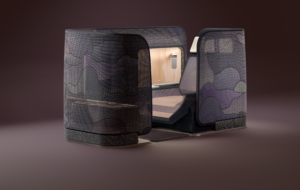|
A densely packed exhibition at the Whitechapel Gallery takes a Kazimir Malevich’s painting as its starting point to assess the history of abstraction and its political undercurrents, says Jessica Mairs Tucked away in one corner of the gallery is a tiny wooden cube – half oak, half pine – sanded smooth to just 9-millimetres-square. Almost imperceptible against the timber floor, it is the smallest and most easily overlooked work included in the Whitechapel’s Adventures of the Black Square, which takes Kazimir Malevich’s Black Quadrilateral as its starting point and fans out globally and chronologically to assess the impact of abstraction on art practice over the past 100 years. The fragility of this minute work, named Southern Cross (1967), by Brazilian conceptual artist Cildo Meireles, is emphasised by the scale of the gallery, densely packed with the bold geometry of constructivist artworks, but it seems representative of the exhibition’s social and political undercurrent. Meireles used this geometric form to represent the political and cultural marginalisation of the Brazilian Tupi Indians, condensing a complex political plight into a simple symbolic form. The two types of wood melded together – considered sacred by the indigenous people because of their ability to produce fire – create a boundary that runs around the circumference of the cube. Behind the frosted glass doors of the lower-floor gallery, visitors are confronted head-on with Malevich‘s Black Quadrilateral (1915) – much less a “black square” than a slightly skewed black rectangle painted on a white background, the paintwork now discoloured and cracked with age. It is one of four “black square” paintings created by the artist as a new departure for painting: a complete rejection of representation in favour of abstraction. It is the centenary of the painting’s first outing, debuted by Malevich at The Last Futurist Exhibition of Paintings 0.10 in Petrograd (now St. Petersburg) in 1915. Hung high on the wall in a spot typically reserved for religious iconography, Malevich presented the work as a beacon of a new genre of non-object art. The Kiev-born artist coined the term suprematism to cover this new movement that focused on geometric form and colour rather than the depiction of objects, people and scenes. He explained in his manifesto, The Non-Objective World (1927), that in “trying desperately to free art from the deadweight of the real world, I took refuge in the form of the square”. The deadweight Malevich was trying to shift during the First World War and the run up to the October Revolution of 1917 was the tradition of figurative art. “Just as in the old days the West, East and South opposed us economically, so it was in art,” he claimed in his Essays on Art (1915-1933). Although passing through cubism, Malevich believed its representational form was now ill-equipped to convey the utopian ideals of a revolutionary society. The influence of the flat, geometric forms of suprematism are present in the reductive compositions of contemporaries Soviet constructivists El Lissitzky and Moholy-Nagy, and in the primary-coloured plains of Mondrian’s and Van Doesburg’s neo-plasticism. Glass vitrines display leaves from Dutch publication De Stijl and Polish BLOK, used to disseminate the ideology behind this new movement. Abstraction’s filtration into everyday life is represented by textile works by Bauhaus artist Anni Albers. In 1950-60s Brazil, the construction of new utopian capital city Brasilia was underway. Members of the neo-concretism movement, Helio Oiticica and Lygia Clark, began to break from the flat plains of colour that dominated early abstraction, exploring three-dimensional space with coloured blocks that implied depth and interactive sculptures that took the geometric form from the page. Twenty years later in post-independence India, Nasreen Mohamedi produced a series of intricate linear drawings, more delicate than the punchy block colours and plains of her predecessors but using the same reductive visual vocabulary. Somewhere around the foot of the stairs to the upper gallery this densely-packed but comprehensive history of abstraction begins to peter out, and it’s hard to tell what implicitly links the works cherry-picked to represent the 1970–2015 section of the show with the cohesive collection of largely geometric works on the lower floor more than any other contemporary visual artist. A few threads draw the exhibition’s conclusion back to Malevich’s roots, namely Rosemarie Trockel’s who strikes up a direct rhetoric with the artist’s work in her woollen image Cogito, ergo sum (1988), which has a black square knitted into one corner; and Keith Coventry’s Sceaux Gardens Estate (1995), a distillation of the utopian ideology and flaws of London’s post-war housing into a series of acid yellow blocks cast adrift on a white canvas. |
Words Jessica Mairs
Adventures of the Black Square: Abstract Art and Society 1915–2015
Images: Collection of Zsolt Somlói and Katalin Spengler; Collezione Maramotti, Reggio Emilia; Tate Collection; Marian Goodman Gallery, New York; Scottish National Gallery of Modern Art, Edinburgh; Galerie Gmurzynska AG; Jack Kirkland Collection; Catherine & Franck Petitgas; Stephen Flavin / Artists Rights Society (ARS), New York; Pace London; Scottish National Gallery of Modern Art, Edinburgh |
|
|



















